Viksit Bharat Sankalp Yatra - Strengthening Health Infrastructure Through Pradhan Mantri Jan Arogya Yojana
Context
- In a significant milestone demonstrating the strengthening of the country’s health infrastructure and propelling healthcare excellence in India, India has achieved a commendable landmark. 1,02,23,619 Ayushman cards have been created during Viksit Bharat Sankalp Yatra.
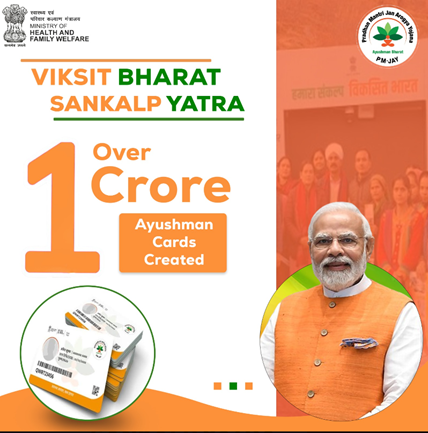
Key Details:
- Under the ongoing Viksit Bharat Sankalp Yatra, the cumulative footfall has reached 1,31,66,365 in 79,487 Health camps conducted in 3,462 Gram Panchayats and Urban Local Bodies, to date.
- The following activities are being carried out in the Health Camps:
- Ayushman Bharat - Pradhan Mantri Jan Arogya Yojana (AB-PMJAY): Under the flagship scheme of MoHFW for the Viksit Bharat Sankalp Yatra, Ayushman cards are being created using the Ayushman app and physical cards are being distributed to the beneficiaries.
- Till date, more than 23,83,473 physical cards have been distributed.
- A total of 6,34,168 Ayushman cards have been created at the health camps held yesterday.
Key facts:
- Tuberculosis (TB): Screening of patients for TB is carried out by screening for symptoms, sputum testing, and using NAAT machines wherever available. Cases suspected to have TB are referred to higher facilities.
- By the end of Day 36, more than 49, 17,356 people had been screened out of which more than 3,41,499 were referred to higher Public Health Facilities.
- Under Pradhan Mantri TB Mukt Bharat Abhiyan (PMTBMA), consent is being taken for patients suffering from TB to receive assistance from Nikshay Mitras. Attendees willing to be Nikshay Mitras are also being provided on-spot registration. More than 1,17,734 patients have given consent under PMTBMBA and more than 39,819 new Nikshay Mitras were registered.
- Under the Nikshay Poshan Yojana (NPY), monetary assistance is provided to TB patients through Direct Benefit Transfer.
- For this purpose, details of the bank accounts of the pending beneficiaries are being collected and accounts are being Aadhaar seeded. Details of 30,093 such beneficiaries have been collected.
- Sickle Cell Disease: In areas with a predominant tribal population, screening of eligible population (up to 40 years of age) is being done for the detection of Sickle Cell Disease (SCD) through the Point of Care (PoC) tests for SCD or through Solubility Test.
- Cases testing positive are being referred to higher centers for management. More than 5,08,701 people have been screened so far, out of which 21,793 were found to be positive and referred to higher public health facilities.
- Non-Communicable Diseases (NCDs): Screening of eligible population (30 years and above) is being done for Hypertension and Diabetes and cases suspected to be positive are being referred to higher centers.
- Around 10,297,809 people have been screened for Hypertension and Diabetes. More than 4,82,667 people were suspected to be positive for Hypertension more than 3,45,898 were suspected to have Diabetes and more than 7,59,451 people were referred to higher public health facilities.
Background:
- The Viksit Bharat Sankalp Yatra was launched by the Hon’ble Prime Minister on November 15 from Khunti, Jharkhand to saturate the benefits of central government schemes across the nation. As a part of on-spot services under the Viksit Bharat Sankalp Yatra, Health Camps are being organized at the places of the halt of the IEC Van in the Gram Panchayats.
About Viksit Bharat Sankalp Yatra:
- The Viksit Bharat Sankalp Yatra is a government initiative being undertaken across the country, to raise awareness about and track the implementation of flagship central schemes, such as Ayushman Bharat, Ujjwala Yojana, PM Surkasha Bima, PM SVANidhi, etc.
- According to the scheme’s websites, it has four aims: “reach out to the vulnerable who are eligible under various schemes but have not availed benefit so far; dissemination of information and generating awareness about schemes;
- interaction with beneficiaries of government schemes through their personal stories/ experience sharing; and enrolment of potential beneficiaries through details ascertained during the Yatra.”
- The program is being undertaken with the active involvement of various Union ministries and state governments.
- According to the government’s Press Information Bureau (PIB), “In a short span of just one month, the Yatra has reached more than 2.50 crore citizens across 68,000 Gram Panchayats (GPs) in the country.
- Further, nearly 2 crore individuals have taken Viksit Bharat Sankalp and over 2 Crore beneficiaries of Central Government Schemes have shared their experiences under the ‘Meri Kahani Meri Zubani’ initiative.” People can take the ‘Sankalp’ (pledge) by filling out a form on the scheme’s website and then downloading a certificate.
Ayushman Bharat Pradhan Mantri Jan Arogya Yojana (PM-JAY)
About:
- It is a flagship health insurance program launched by the Government of India in 2018.
- The scheme aims to provide financial protection to vulnerable and economically weaker sections of society by offering health coverage for secondary and tertiary hospitalization.
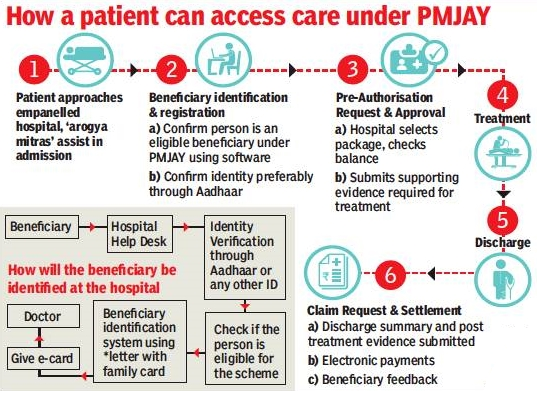
Features
- Universal Health Coverage: PM-JAY aims to cover over 100 million poor and vulnerable families, approximately 500 million beneficiaries, with a health insurance cover of up to ₹5 lahks per family per year for specified secondary and tertiary care treatments.
- Cashless Treatment: Beneficiaries can avail of cashless and paperless treatment at impanelled public and private hospitals across India.
- Empanelled Hospitals: The scheme has a network of both public (government) and private hospitals. As of the data mentioned earlier, around 15,000 private and 12,000 government hospitals are impanelled under PM-JAY.
- No Cap on Family Size: The scheme covers the entire family, including up to five members, and there is no cap on the family size or age of family members.
- Pre-existing Conditions: PM-JAY covers pre-existing conditions from day one of enrollment, ensuring access to treatment for existing health issues.
- Portability: The scheme is portable across India, meaning beneficiaries can avail of treatment in any impanelled hospital in any state or union territory.
Significances:
- Financial Protection: PM-JAY provides a crucial safety net to vulnerable sections of society by protecting them from catastrophic health expenditures that can push families into poverty.
- Improved Access to Healthcare: By providing cashless treatment at impanelled hospitals, PM-JAY enhances access to quality healthcare for millions of beneficiaries who may not have had access to it otherwise.
- Reduced Out-of-Pocket Expenditure: The scheme reduces the burden of out-of-pocket expenses for medical treatments, making healthcare more affordable for the poor.
- Health Outcomes: PM-JAY aims to improve health outcomes by facilitating timely access to appropriate medical care, especially for serious illnesses that require secondary and tertiary care services.
- Strengthening Healthcare Facilities: The scheme incentivizes hospitals to participate and improve their facilities to meet the standards required for empanelment, thus contributing to the overall improvement of healthcare infrastructure.
Challenges:
- Inactivity of Empanelled Hospitals: As mentioned earlier, a significant number of hospitals impanelled under PM-JAY are inactive, which poses a challenge in ensuring adequate healthcare access for beneficiaries.
- Quality of Care: While the scheme focuses on financial protection, ensuring the quality of care delivered at impanelled hospitals is essential to achieve positive health outcomes.
- Information and Awareness: Some eligible beneficiaries might not be aware of the scheme or how to access it, leading to underutilization of the benefits.
- State Disparities: The level of implementation and participation may vary across states, leading to disparities in healthcare access among beneficiaries.
Challenges of the health sector in India:
Inadequate Healthcare Budgeting
- India allocates only 2.1% of its GDP to healthcare in the fiscal year 2021-22, a stark contrast to countries like Japan, Canada, and France, which invest around 10% of their GDP in public healthcare.
Urban-Centric Healthcare System
- The healthcare infrastructure in India is heavily concentrated in urban areas, neglecting the healthcare needs of the rural majority. This urban-centric approach exacerbates health disparities and limits access to medical services for a significant portion of the population.
Insufficient Focus on Medical Research
- Research and development, particularly in cutting-edge medical technology, receive inadequate attention in India. The lack of emphasis on medical research hinders the country's ability to advance healthcare solutions and innovations.
Challenging Doctor-Patient Ratio
- India grapples with a doctor-patient ratio of 1:1500, significantly higher than the WHO's recommended norm of one doctor for every 1,000 people. This imbalance puts a strain on the healthcare system, resulting in reduced quality of care and limited accessibility.
Dominance of the Private Sector in Expenditure
- Approximately 80% of healthcare expenditure in India is attributed to the private sector, leaving only 20% for public healthcare initiatives. This disproportionate reliance on private contributions underscores issues of affordability and limits access to essential healthcare services for a considerable portion of the population.
Private Sector Dominance in Infrastructure and Personnel
- The private sector holds a substantial presence in India's healthcare landscape, accounting for 58% of hospitals and 81% of doctors. This dominance further reinforces the disparities in healthcare accessibility, as private facilities often cater to urban and affluent populations, exacerbating the existing inequalities.
Government initiatives:
National Health Mission (NHM)
- Launched in 2005, the National Health Mission is a flagship initiative aimed at addressing healthcare challenges in India.
- It integrates various health programs and focuses on maternal and child health, family planning, and controlling infectious diseases.
- The NHM plays a crucial role in strengthening healthcare infrastructure and services across the country.
Ayushman Bharat
- Launched in 2018, Ayushman Bharat is a transformative initiative with two key components:
- Health and Wellness Centers (HWCs) and the Pradhan Mantri Jan Arogya Yojana (PM-JAY). Ayushman Bharat aims to provide comprehensive primary healthcare through HWCs and financial protection against catastrophic healthcare expenses through PM-JAY, which offers insurance coverage to vulnerable families.
Pradhan Mantri Jan Arogya Yojana (AB-PMJAY)
- AB-PMJAY, launched under Ayushman Bharat, is the world's largest government-sponsored health insurance program.
- It provides financial protection to over 100 million vulnerable families, offering coverage for hospitalization and surgeries.
- The scheme aims to reduce the financial burden on families and improve access to quality healthcare services.
PM National Dialysis Programme
- This program, launched as part of the National Health Mission, focuses on providing affordable and accessible dialysis services across the country.
- By establishing dialysis centers and supporting dialysis procedures, the initiative aims to address the increasing prevalence of renal diseases and ensure that individuals in need receive timely and affordable treatment.
Janani Shishu Suraksha Karyakram (JSSK)
- Launched in 2011, JSSK is a part of the National Health Mission and focuses on ensuring free and cashless access to maternal and newborn healthcare services.
- It provides financial assistance to pregnant women, covering delivery-related expenses and postnatal care. JSSK aims to encourage institutional deliveries and improve maternal and child health outcomes.
Rashtriya Bal Swasthya Karyakram (RBSK)
- Initiated in 2013 under the National Health Mission, RBSK focuses on early detection and management of health conditions in children aged 0-18 years. The program includes health screening, early intervention, and treatment of diseases and disabilities.
- RBSK aims to ensure that health issues in children are identified and addressed at an early stage, promoting overall child health and well-being.
Closing thoughts
- Investment in New Healthcare Facilities: Allocating funds for the construction of new healthcare facilities, especially in underserved rural areas, is crucial. This expansion ensures that medical services are geographically accessible, addressing the urban-rural healthcare divide.
- Upgrading Existing Facilities: Improving the quality and capabilities of existing healthcare facilities is equally vital. Upgrades should include the integration of advanced medical technologies, enhanced infrastructure, and adherence to international healthcare standards.
- Training and Recruitment of Medical Professionals: To address the doctor-patient ratio disparity, investing in the training and recruitment of more medical professionals is essential. This includes doctors, nurses, paramedics, and support staff. Initiatives to encourage medical education and attract talent to underserved areas can contribute significantly.
https://pib.gov.in/PressReleaseIframePage.aspx?PRID=1989512
https://indianexpress.com/article/explained/everyday-explainers/pm-modi-varanasi-what-is-viksit-bharat-sankalp-yatra-kashi-tamil-sangamam-9071956/
https://pib.gov.in/PressReleseDetail.aspx?PRID=1989512
https://twitter.com/airnewsalerts/status/1738203764417589436
https://www.takeonedigitalnetwork.com/viksit-bharat-sankalp-yatra-kathua-resident-hails-pms-ayushman-bharat-healthcare-scheme/
https://newsonair.gov.in/Main-News-Details.aspx?id=472767
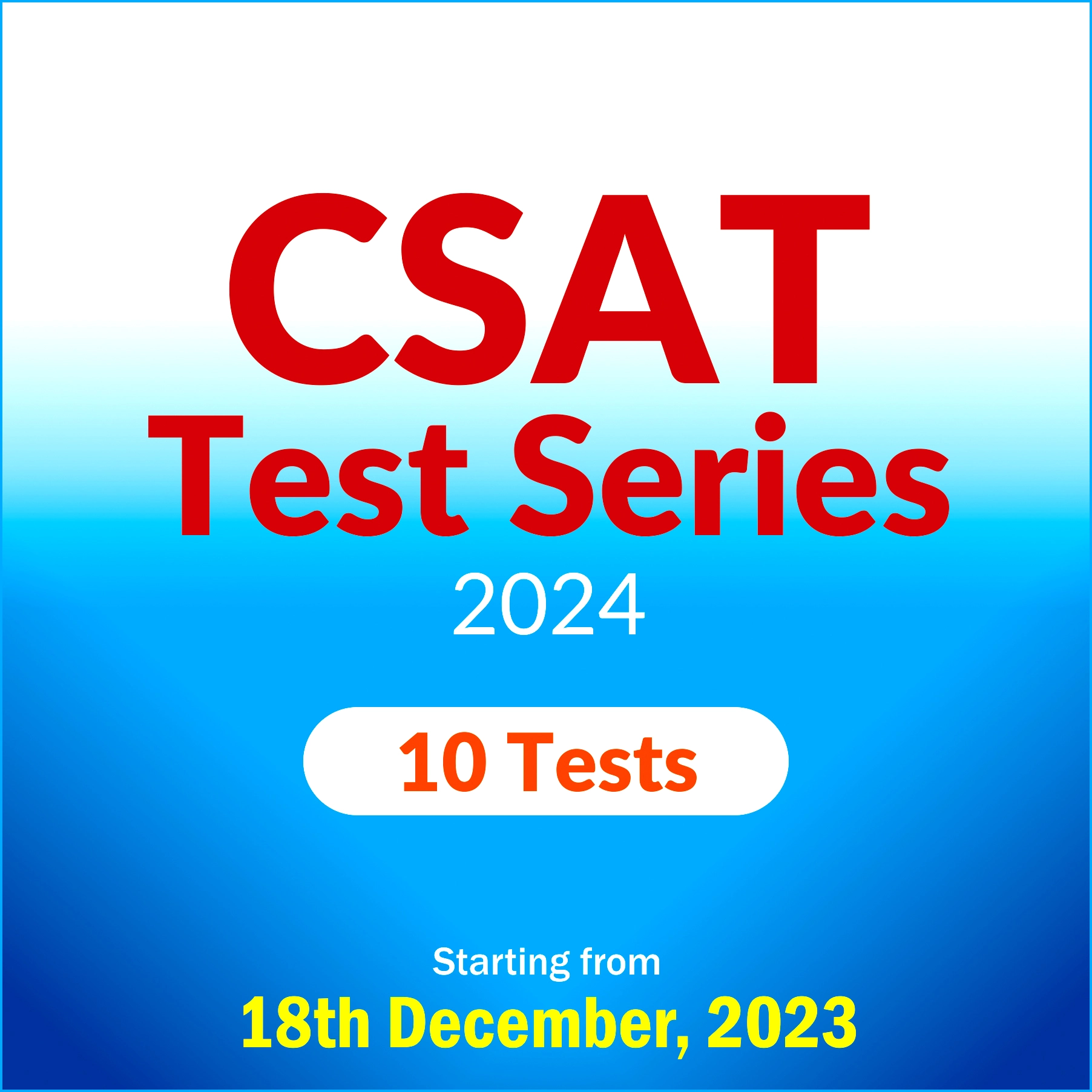
India Meteorological Department (IMD)
Context
- Cold wave conditions continue to prevail in North India.
Details:
- The India Meteorological Department (IMD) has forecast that dense to very dense fog conditions are likely to continue over northwest and parts of adjoining Central India during the next 3 to 4 days.
- It also predicted dense to very dense fog conditions are likely to continue in the early hours in many parts of Punjab till Sunday and in some parts of Haryana, Chandigarh, Delhi, and Uttar Pradesh till Friday.
- IMD has forecast a fresh western disturbance that is likely to affect North-west India from the 30th of this month.
- The IMD also forecasts no significant change in minimum temperatures in northern parts of the country during the next 5 days.
About India Meteorological Department (IMD):
- The India Meteorological Department (IMD) is an agency of the Ministry of Earth Sciences of the Government of India.
- It is the principal agency responsible for meteorological observations, weather forecasting, and seismology.
- IMD is headquartered in Delhi and operates hundreds of observation stations across India and Antarctica.
- Regional offices are in Chennai, Mumbai, Kolkata, Nagpur, Guwahati and New Delhi.
- IMD operates a network of hundreds of surface and glacial observatories, Upper Air (high altitude) stations, ozone and radiation observatories, and meteorological radar stations.
- Additional data is received from India's constellation of satellites, such as Kalpana-1, Megha-Tropiques, and instruments on board the IRS series and the INSAT series of satellites.
https://newsonair.gov.in/News?title=Cold-wave-conditions-continue-to-prevail-in-North-India%3b-Dense-fog-envelopes-national-capital-affecting-rail%2c-road-and-air-traffic&id=474067
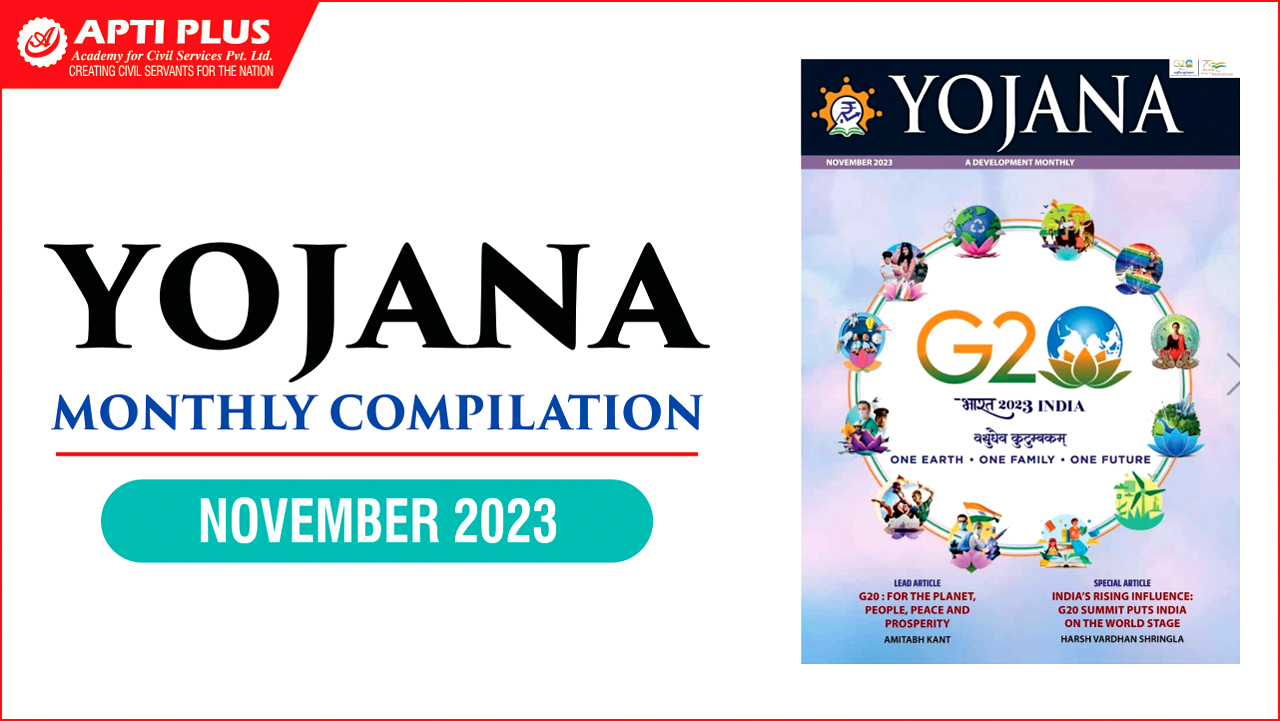
Minimum Support Price for Copra
Context
- The Cabinet Committee on Economic Affairs CCEA today approved the Minimum Support Price MSP for Copra for the 2024 season.
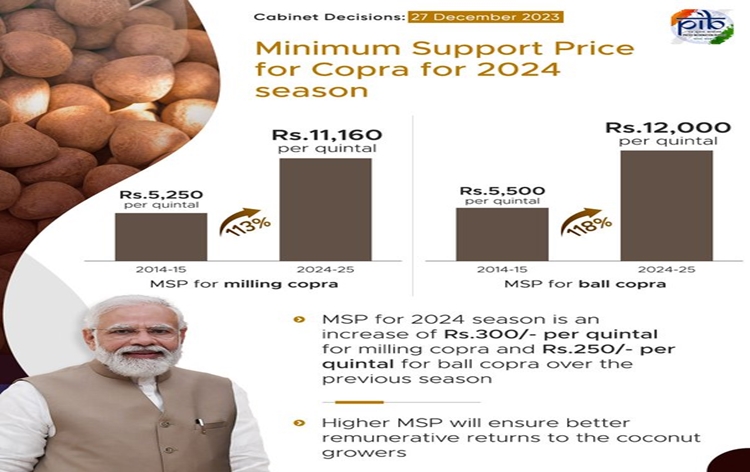
Disclaimer: Copyright infringement is not intended
Details:
- Briefing media in New Delhi, Information and Broadcasting Minister Anurag Singh Thakur said, the MSP for the 2024 season is an increase of 300 rupees per quintal for milling copra and 250 rupees per quintal for ball copra over the previous season.
- He said, higher MSP will ensure better remunerative returns to coconut growers. In 2014-15, for milling copra, MSP was five thousand 250 rupees per quintal and in 2024-25 it will be 11 thousand 160 rupees per quintal.
- For ball copra, in 2014-15 MSP was five thousand 500 rupees per quintal and in 2024-25 it will be 12 thousand rupees per quintal. This will ensure a margin of 51.84 percent for milling copra and 63.26 percent for ball copra, which are well beyond 1.5 times the all-India weighted average cost of production.
- Milling copra is used to extract oil, while ball or edible copra is consumed as a dry fruit and used for religious purposes. Kerala and Tamil Nadu produce million copra, whereas ball copra is produced predominantly in Karnataka. In the current season 2023, the Government has procured a record amount of more than 1.33 lakh metric tonnes of copra, at the cost of 1,493 crore rupees, benefiting around 90 thousand farmers.
- The procurement in the current season 2023 indicates a rise of 227 percent over the previous season.
About Minimum Support Price:
- The minimum support price (MSP) is an agricultural product price, set by the Government of India to purchase directly from the farmer. This is not enforceable by law.
- This rate is to safeguard the farmer to a minimum profit for the harvest if the open market has a lesser price than the cost incurred.
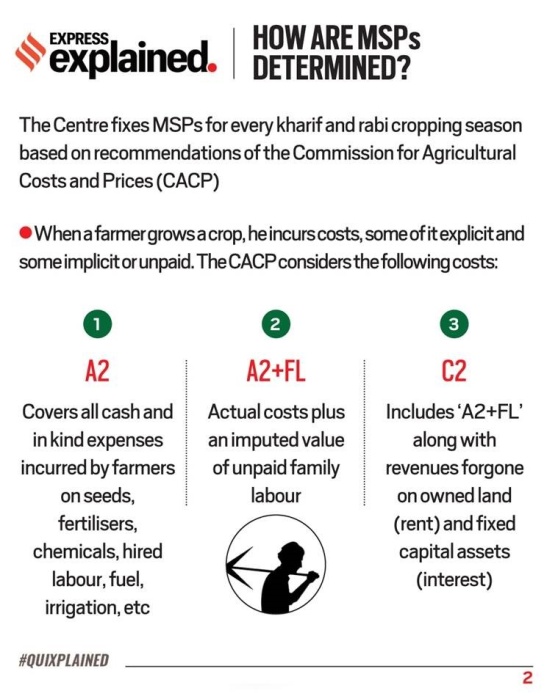
Procurement
- The procurement at MSP is being done by Central and State Agencies under various schemes of Government.
- Procurement centers are opened by respective State Government Agencies and Central Nodal Agencies like NAFED, FCI, etc.
- This is done after taking into account the production, marketable surplus, convenience of farmers, and availability of other logistics/infrastructure such as storage and transportation, etc.
https://newsonair.gov.in/News?title=Cabinet-approves-Minimum-Support-Price-for-Copra-for-2024-season&id=474081

Digital Life Certificates
Context
- The government has set a target of 50 lakh Digital Life Certificates by Central Government Pensioners by March next year.
Details
- The Department of Pension and Pensioners’ Welfare reviewed the nationwide Digital Life Certificate Campaign 2.0 with Pensioners Welfare Associations and Nodal Officers of 16 Banks.
- During the meeting, Secretary, Department of Pension & Pensioners’ Welfare V Srinivas stressed the need for a saturation approach to ensure Digital Life Certificate submission by all pensioners. He added that a highly focused approach should be adopted for DLCs of super senior pensioners above 80 years of age.
- He also said digital empowerment of pensioners is a stated goal of the Government with a policy of Minimum Government and Maximum Governance.
- Under the DLC Campaign 2.0, 1.29 Crore pensioners have submitted DLCs so far, of which, more than 41 Lakh are Central Government Pensioners.
About the Digital Life Certificates (DLCs) and Jeevan Pramaan:
|
About
|
- The campaign revolves around generating Digital Life Certificates (DLCs), also known as Jeevan Pramaan, for Central Government pensioners.
- A DLC serves as a way to digitally verify a pensioner's existence, ensuring they continue to receive their pension benefits.
|
|
Ease of Submission
|
- The initiative aims to simplify the DLC submission process for pensioners.
- Notably, elderly pensioners aged above 90 years and those between 80-90 years old can conveniently submit their DLCs from their homes, various locations, offices, and bank branches.
|
|
Campaign Progress
|
- By the end of the first week of DLC Campaign 2.0, more than 16 lakh DLCs were generated.
- Maharashtra and Uttar Pradesh emerged as leading states, contributing significantly to the campaign. In the first week alone, an estimated 4 lakh DLCs were generated.
|
|
Nationwide Reach
|
- The campaign's scope is extensive, covering 500 locations in 100 cities across the country.
- The target audience comprises 50 lakh pensioners from the Central Government.
|
|
Collaborative Effort
|
- The campaign operates through collaboration with multiple stakeholders, including 17 Pension Disbursing Banks, various Ministries and Departments, Pensioners' Welfare Associations, UIDAI (Unique Identification Authority of India), and MeitY (Ministry of Electronics and Information Technology).
|
https://newsonair.gov.in/News?title=Government-sets-target-of-50-lakh-Digital-Life-Certificates-by-Central-Government-Pensioners-by-March-next-year&id=474070

Egypt proposes a three-phase plan
Context
- Egypt has proposed a three-phase plan to end the ongoing war between Israel and Hamas.
Details:
- In the first phase of the plan, Israel would be expected to pause its military operations for one to two weeks for Hamas to release 40 hostages, including women and the elderly.
- The second phase includes an agreement of the exchange of bodies of Hamas militants held by Israel for the bodies of Israeli hostages held by Hamas.
- the third phase of the plan includes an ‘all-for-all’ deal meaning Israel would return 6,000 Palestinian prisoners in its jails for the remaining Israeli hostages including soldiers, Hamas is holding in captivity.
About the Egypt-India Relations:
|
Historical Ties
|
- Egypt and India share ancient historical and cultural connections that date back centuries.
- Trade and cultural exchanges flourished between the two regions, primarily through maritime routes.
|
|
Diplomatic Relations
|
- Egypt and India established diplomatic relations in 1955, shortly after Egypt gained independence from colonial rule.
- Both countries have maintained a positive and friendly relationship over the years, characterized by frequent high-level visits and cooperation.
|
|
Economic Cooperation
|
- Bilateral trade between Egypt and India has been growing steadily. In 2020, the total trade volume reached approximately $3 billion.
- Areas of cooperation include agriculture, information technology, tourism, pharmaceuticals, and textiles.
- Both countries have signed various agreements to enhance economic ties and facilitate investments.
|
|
Political Cooperation
|
- Egypt and India have collaborated on multilateral platforms such as the United Nations, the Non-Aligned Movement, and the Indian Ocean Rim Association (IORA).
- They have supported each other's candidatures for various international positions and have coordinated positions on global issues.
|
|
Defense and Security Cooperation
|
- Defense cooperation between Egypt and India has gained momentum in recent years, including exchanges, joint exercises, and defense equipment procurement.
|
https://newsonair.gov.in/News?title=Egypt-proposes-a-three-phase-plan-to-end-ongoing-war-between-Israel-and-Hamas&id=473990







